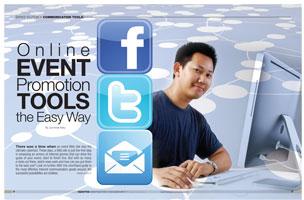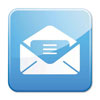
There was a time when an event Web site was the ultimate cybertool. These days, a Web site is just the first step in amassing an armory of Internet gizmos that can drive the goals of your event, start to finish line. But with so many e-tools out there, which ones work and how can you put them to the best use? Look no further. With this shorthand guide to the most effective Internet communication goods around, the successful possibilities are endless.
Facebook With more than 300 million active users, Facebook is arguably the best way to reach anyone, anywhere. As a result, a Facebook event page is one of the best, not to mention easiest, ways to communicate with your event's audiences, whether they are fans, participants or the media. Facebook requires minimal investment of time and budget, so it's time to get your event in the Facebook universe right away.
With more than 300 million active users, Facebook is arguably the best way to reach anyone, anywhere. As a result, a Facebook event page is one of the best, not to mention easiest, ways to communicate with your event's audiences, whether they are fans, participants or the media. Facebook requires minimal investment of time and budget, so it's time to get your event in the Facebook universe right away.
You can actually build a Facebook event page even before your event Web site is up. All you need are the basics - who, what, when and where - to get started.
After you've done the five-minute work of setting up your Facebook page, the next step is to start making friends. First, if your event is on Facebook, you should add a Facebook widget to your Web site. It will increase search engine hits for your event and drive interested people to get involved and stay that way.
Next, look to your event's existing contact list, but don't limit yourself. Send an invitation to everyone in your own address book, and have everyone who works with your event do the same. You'll be surprised how many people - even those who have no intention of attending your event - will join the page just to support a friend or colleague. When they join your event page, Facebook notifies all of their friends, and suddenly you've expanded your contact list exponentially. If you have influential friends or contacts - a celebrity in your sport or perhaps a networking-savvy connection with a huge bank of pals - enlisting those people as fans of your event is a great strategy for ramping up your Facebook exposure.
Making wall posts to your Facebook page - and these can be the same as your Twitter posts, which is coming up - is another great way to keep your event front-and-center as well as to communicate event news. Another smart strategy for building interest in your event is to post photos: of past events, of the facility, of the city where the event will take place, and things to do and see there. If there are people in your photos, tagging them is a great way to draw page visitors too. Just be sure that, if necessary, you've got a photo release on file.
Twitter A lot of people are asking: Is this Twitter thing for real, or is it just a flash in the cyberspace pan? Twitter was once a trendy tool used mostly by the tech-forward, but lately it has gone mainstream and with good reason. First of all, Twitter is free. You can microblog unlimitedly about your event without racking up additional marketing costs. And with a little Tweeting know-how, you can not only increase participation, attendance and community involvement in this year's event, you can build a following that will feed interest in all your future events as well.
A lot of people are asking: Is this Twitter thing for real, or is it just a flash in the cyberspace pan? Twitter was once a trendy tool used mostly by the tech-forward, but lately it has gone mainstream and with good reason. First of all, Twitter is free. You can microblog unlimitedly about your event without racking up additional marketing costs. And with a little Tweeting know-how, you can not only increase participation, attendance and community involvement in this year's event, you can build a following that will feed interest in all your future events as well.
Before your event: Choose your Twitter handle. It's a good idea to use the name of your event, making it easier for participants, fans and media to find and follow you. After that, start building your Twitter nest of followers. Use your participant list to search for existing Tweeters and to invite new Tweeters to follow you. Also, use Twitter's simple wizard, which allows you to customize to your brand's look and feel, to add a Twitter widget to your blog or Web site. Finally, use Twitter search engines Tweet Scan or Twitter Search to find people who are covering related topics. Adding those people, companies or media outlets to the list of people you follow is a great way to bring your event to their attention.
 Once you've built a strong list, start Tweeting. Land an exciting judge or post-event act? Tweet it. You can use Twitter to share practical updates, like a change in start time, with participants as well. The most important thing is to make sure all your Tweets are meaningful, so make every 140-character post count.
Once you've built a strong list, start Tweeting. Land an exciting judge or post-event act? Tweet it. You can use Twitter to share practical updates, like a change in start time, with participants as well. The most important thing is to make sure all your Tweets are meaningful, so make every 140-character post count.
During your event: Now is your chance to provide real-time coverage, show off everything your event offers and build excitement and event loyalty. Add a Twitter stream to your Web site or blog (another easy-to-add application available through Twitter), and consider having athletes guest-Tweet as the event occurs, particularly for multiple day events. Include stories from the event, memorable moments or quotes, new statistics and records.
For events with a big spectator or fan base, get those people involved by including fan or parent Twitter streams on your Web site or blog as well.
After your event: Keep with the Tweet and keep participants and fans up-to-date and excited about next year's events. Consider Tweeting interesting tidbits like what competitors are up to throughout the year, their stats and scores and how rivalries are playing out throughout the season of your sport. Just keep it meaningful and you'll keep your audience hooked. That's the beauty of Twitter.
Email It may seem obvious, but email is a great way to communicate event news and to build loyalty. Thanks to the increasing popularity of using the Web for achieving all sorts of tasks from banking to shopping, people are much less shy about giving out their email addresses these days. That means you can easily build a robust contact list that will serve your event well before, during and long after the last award is handed out.
It may seem obvious, but email is a great way to communicate event news and to build loyalty. Thanks to the increasing popularity of using the Web for achieving all sorts of tasks from banking to shopping, people are much less shy about giving out their email addresses these days. That means you can easily build a robust contact list that will serve your event well before, during and long after the last award is handed out.
However, there is one huge caveat: the spam quandary. You don't want even a whiff of spam in your event's emails, and not just because spamming is illegal. Spam filters will relegate your important updates to the junk folder, where they can do nothing to advance your event's goals. And while spam filters are imperfect, you can follow a few simple rules and your emails will be much more likely to bring home whatever trophy you desire, from upping registration numbers to increasing fan attendance.
Get permission. Avoid spam complaints, make a good impression and above all, get your email into that inbox by asking your contact list for permission to send them emails. This can be through a simple opt-in introductory email, part of the application to participate in your event and/or through a sign-up on your Web site.
Focus on the subject. The subject line of your email, while it might seem like a small thing, is key. You want it to stand out in the Inbox without screaming spam. Be specific, keep it concise and avoid words like "free" that will get your mail snatched by filters.
Make it easy. You might not have a marketing department with graphic and Web designers on hand to craft your emails and e-newsletters. Not to worry. You can still send a classy, brand-building communications. Look to one of the many email marketing providers, such as iContact and Mail Chimp, which provide easy-to-use design tools and email marketing resources for a seriously affordable fee.
The Web has a wealth of communications tools, more than some events need or want. But the most important thing is to get the word out. Choose the tech tools that fit your event's capabilities and goals the best, and get started today.

